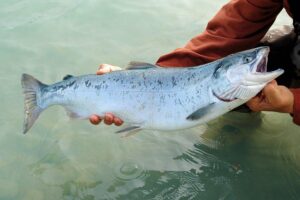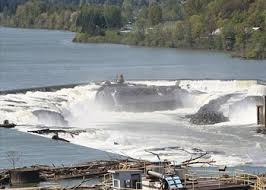Visiting Willamette Falls and learning about the Willamette Falls Fish Count has been one of the most eye-opening experiences of my journey with rivers and fish. For many years, I have been fascinated by how fish move through rivers, how their numbers change with time, and what those numbers actually mean for people, for fishing, and for nature itself.
When I first came across the Willamette Falls Fish Count, it wasn’t just numbers on a chart—it felt like a story being told by the fish themselves. Each count represents thousands of lives traveling through the fishway, and in some ways, it represents our own relationship with the environment too.
A Little History of the Willamette Falls Fish Count
Willamette Falls is not just another waterfall. It is a powerful natural landmark in Oregon and has played a big role in the region’s history. The first fish ladder here was built way back in 1885. Over the years, it has been rebuilt and improved in 1893, 1904, and again in 1975.
Today, there are three fish ladders that come together into a single exit above the falls. This allows salmon, steelhead, and other species to pass through on their journey upstream. Without these ladders, many of these fish wouldn’t be able to reach their spawning grounds.
For me, standing near the fishway and knowing that fish have been using it for over a century made me feel connected to something larger than myself—a story of survival and adaptation.
How the Fish Count Works
The Willamette Falls Fish Counts is managed by the Oregon Department of Fish and Wildlife (ODFW). They use a video camera system that records fish passage 24 hours a day, 365 days a year. Later, trained staff review the footage to identify the species, whether the fish are wild or hatchery-raised, and to make daily counts.
I was amazed at the detail. Imagine watching countless hours of tape just to count fish swimming by. It reminded me that conservation isn’t glamorous—it’s careful, consistent, and sometimes tedious work. But that dedication keeps our rivers alive.
The Fish We See in the Counts
The main species counted are:
- Spring Chinook Salmon – known for their strength and long migrations.
- Fall Chinook Salmon – another important run that comes later in the year.
- Winter Steelhead – famous for their fighting spirit, valued by anglers.
- Summer Steelhead – another strong fish, but their run timing is different.
- Coho Salmon – smaller but incredibly important to the river system.
Interestingly, Pacific Lamprey also climb the ladders, but they are not part of the official counts. Seeing lampreys cling to rocks and ladders was unforgettable—they are like living fossils, surviving in ways that feel almost prehistoric.
Why These Counts Matter
At first, fish counts might look like boring statistics. But when I really thought about it, I realized each number represents a living creature fighting against the current, trying to survive. These counts tell us:
- Population Health – Are salmon and steelhead numbers rising or falling?
- Conservation Needs – If numbers drop too low, action is needed.
- Fishing Regulations – Seasons and limits are often based on these counts.
- Climate Change Effects – Warmer water, droughts, and floods all affect migration.
- Community Connection – Local people, anglers, and even children use these counts to learn about their rivers.
When I looked at decades of data, I could see how some years were full of fish, while others had worryingly low numbers. It was an emotional reminder that nature is not guaranteed—it needs care.
My First Visit to the Fishway
When I finally visited the viewing window near the PGE Sullivan Power Plant, I didn’t expect it to be so moving. The sight of fish pushing forward, some tired and scarred, others bright and strong, filled me with respect.
It felt like watching determination in action. These fish don’t give up. They leap, swim, and climb because their life depends on reaching the spawning grounds. For me, it was not just science—it was a lesson in persistence.
Lessons I Took from the Willamette Falls Fish Counts
Here are some of the big lessons I carried with me:
- Every Fish Matters – One salmon in the count could mean thousands more in the future.
- Human Help is Necessary – Without ladders and monitoring, many fish populations would collapse.
- Nature and People are Connected – Our choices—fishing, farming, dam building—directly shape these numbers.
- History Lives in the River – Fish ladders from the 1800s to now tell a story of humans learning how to coexist with salmon.
- Hope is Still Alive – Even when numbers fall, fish keep returning, year after year.
The Emotional Side of Numbers
Looking at the Willamette Falls Fish Counts is not like reading a sports scoreboard. It’s like reading a diary of the river. I felt sadness when I saw low years, but I also felt hope when strong runs appeared.
It reminded me that every number is a heartbeat in the river. Behind the statistics are living, breathing creatures. And behind them are people—anglers, biologists, children on school trips—who care deeply about what happens here.
Moving Forward
The future of Willamette Falls and its fish will depend on how we respond to challenges:
- Habitat Restoration – Rivers need clean, cool water.
- Climate Action – Rising temperatures can change migration patterns.
- Community Awareness – The more people who learn about fish counts, the stronger the support for conservation.
- Respectful Fishing – Taking only what we need and following regulations ensures future runs.
- Innovation – Just like ladders were invented over a century ago, new solutions may be needed for tomorrow’s problems.
Final Thoughts
The Willamette Falls Fish Count is more than a record of fish passing through a ladder. It is a reminder of resilience, history, and the ongoing relationship between people and rivers.
For me, it was personal. Watching the fish struggle yet succeed made me think about my own challenges. If a salmon can swim thousands of miles and leap up waterfalls, maybe I can face my obstacles too.
I left Willamette Falls not just informed, but inspired. The river spoke through the numbers, and I listened.
2025 Monthly Counts



